Editorial
I've had a rather awful month, courtesy of the poisons my doctor has been transfusing me with. An unpleasant and direct result of this has been a large amount of time spent in the smallest room of the house, with old copies of the Model Engineer for company. The easiest shelf to reach as I rushed past the library was the 1960's, and as I've already read everything Westbury wrote in this period several times, I decided to broaden my education with the writings of LBSC, Martin Evans, Don Young, and the like. The thing that leaps out at me from their series is the way they concentrate on the "how" of their projects to the almost total exclusion of the "why".
All three published designs intended expressly for the beginner, and while the operations required to complete a successful component are abundantly present, there's nary a word on why the thing in question is designed the way it is and how it works. I can't buy them assuming that anyone building a live-steam locomotive was already expertly knowledgeable in all aspects of the theory behind all the myriad sub-systems. I know that column-inches are precious in the old print world, but these things are important too, especially to the beginner struggling to make a working model; if you don't understand why it works, you won't be in a very strong position to figure out how to fix it if it doesn't!
Sadly, this trend continues, both in the ME, and companion Model Engineers' Workshop (MEW) magazines. In the latter, I've noticed that most authors of articles describing some exotic piece of workshop equipment or tooling spend most of their column-inches describing how to make it, but give scant coverage of how to use it, and almost nothing on how and why it works. I hope, in contrast, that my own writings in these pages gives adequate why as well as how, and look to readers to tell me if this is not the case.
On the global front, what is Mother Nature up to! Hundreds dead in the US from tornados, another earthquake, and more towns in Australia being flooded, one for the fourth time. Even worse, I can't find any fundamental stupidity committed by Microsoft of recent times to complain about (unless you count Windows 7). Oh well. At least last month's experiment of a Briefly Noted section worked well, so that will now be a permanent feature of the main index. To business...
Schroeder 09
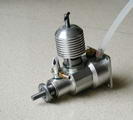
Taking a well-earned break from mass producing Humbugs, Michael Atkinson (Cornwall, UK) has just completed a Schroeder 09 from the plans on this site kindly donated by the late Roger J Schroeder. Like the Humbug, Roger's 09 is an all bar-stock engine intended for the beginner featuring spark or compression ignition (diesel). The design harks back to the 1970's when machine shop was still taught in high schools in the USA and many other countries, so it was not an unreasonable thing to expect a beginner to cut threads (something I could not expect when the Humbug was designed in the early 21st century). It also features twin ball races which require some precision in achieving concentricity and fits, but really, it's just a matter of reading enough to understand where the expected trouble areas are, planning accordingly, evaluating ruthlessly, and being prepared to scrap a part and try again. Good work, Michael; Roger would be proud.
Bi-Rotary, Again
I'm starting to wonder if there is any country left on the planet where some determined engineer has not tried to make a go of the bi-rotary, or differential radial concept. My introduction to the thing was through being asked for an opinion regarding the uniqueness of an Australian bi-rotary designed by Colin Clifford. A short search led me to the 1930 Mawen differential rotary. Then in 2008, MEB published details of Jerry Hales's differential rotary model engine. Enough? Not nearly...
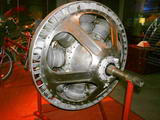
This past month, we received an email from a reader with links to the Swedish differential radial (or bi-rotary if you prefer) designed for the SAAB 17 (no relation to the Boeing B17). This engine, designed by a division of the Swedish giant, Nydqvist & Holm AB (NOHAB), was not a success, so the SAAB 17 A and B models were powered by license-built P&W Twin Wasp and Bristol Mercury radials respectively, the former built by NOHAB. But wait, there's more. The same email provided links to two modern European designs currently in development; one is from Russia by the Skyline Construction Bureau, the other is a Dutch design by Devaere Engineering (whose gallery page contains a couple of unaccredited images from the MEN pages listed earlier, but that's ok  ).
).
Altogether, a fascinating concept that never ceases to attract engineers and backers for some reason, but one that is, in my humble opinion and for reasons stated in previous writings, fatally flawed, or at best, a small niche market product. For example, the Eiffel language contains many features that should make it superior to most others for complex application development. Nevertheless, I'd never recommend it for a project due the difficulty I know I'd have finding competent maintenance programmers to keep that system running after it was built. Differential rotaries face a similar problem; where is the expertise to repair and maintain them? And remember we are talking aircraft engines with lives in the balance in the air and crash path. Still, if no one tries, no one succeeds; earnest good luck to the new entrants.
Cool Exhaust
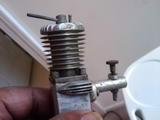
The Boys have no idea what it is, but we all love the cool exhaust stacks! For more photos and some rudimentary analysis of the visible features, click to pic, or follow this link to Watzits: Page 7. Not much else we'll say about it here; it's all in the Watzit entry, but I need to rattle on a few more words to get enough text around the picture that it does not interfere with the next news item (now you know...  ).
).
Gallery
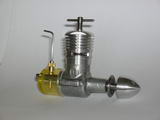
The Engine Builder's Gallery gets a couple of new entries this month and gave me quite a problem for this news entry deciding which of two pictures to feature as the heading photo; both being superb examples of the art. Finally I've gone with Jim Frew's ED Hornet restoration as one of those cases the we Motor Boys love; the sort where the restorer makes more parts than he starts with and returns another classic engine to the land of the living. A very close second is Ian Monro's bar-stock 4-stroke based on some Enya bits and a lot of his own work. Two great accomplishments and well worth a look.
Ron Moulton Auction

We've been notified that Dominic Winter, Specialist Auctioneers and Valuers of Mallard House, Broadway Lane, South Cerney, Gloucestershire GL7 5UQ (UK), are conducting a sale of Aviation and Transport collections on Wednesday, May 18 next. Of special interest to us is Lot #158, comprising 75 boxes of photographs, negatives, documents, periodicals, clippings, correspondence, etc belonging to the late Ron Moulton. The auctioneers have valued the RGM collection at £700-1000.
I've mixed feelings about this. For the sake of Ron's family, I would hope their estimation is in the ball park, but on the other hand, what value does this mound of historical data have to anyone but a few dwindling aeromodelling and model making historians—a group who collectively don't have the traditional two beans to rub together on a good day with a following wind? In the US, a body like the Academy of Model Aviation (AMA) might act to preserve the material of such a pioneer as Ron Moulton. However I somehow doubt that the British Model Flying Association (BFMA) would have the resources, neither financial nor curatorial, to do so. Even worse, Ron's collection of memorabilia relating to the start of control line in the UK through to the early development of digital proportional RC will have scant relevance to the modern "aeromodeller". Damn it! I'm feeling old, obsolete, and depressed just thinking about it. When does the next one-way rocket to the Mars colony leave and do they need someone who can run a lathe...
Where's My Jetpack?
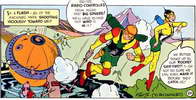
If you don't recognize it, that's a book title for a humorous but insightful look at the future which was promised, but somehow failed to arrive (see Amazon's review here). There are very good reasons why you don't have a Jetpack in the closet, or a flying car in the garage (though one crazy Frenchman certainly does), so it's encouraging to me to see that despite all the valid barriers, there are still people out there who can dream the dream and try to do something about it. We've seen a few examples of aircraft without conventional wings fixed and rotary over the years, and with modern computer aided control, the number seems to be on the increase. Test models of some show they can actually work and with the exception of whose "wings" looked remarkably like an old push-mower, these generally involve some form of ducted fan(s). However, there are other approaches.
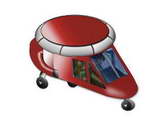
The latest EAA Experimenter newsletter has a link to Yet Another Wingless Wonder that breaks violently with tradition: the Vortex Aerodynamic Platform Aircraft. The paper gives enough detail to make me think it may actually work, but as the designer is 74, I doubt we'll ever see it translated to metal, carbon fiber, whatever. IMHO, the main obstacle to the general availability of the Jetpack, or personal air-vehicle is safe traffic control. Experience amply shows how badly your neighbors are at maneuvering in two dimensions on a road where at least they can stop. I shudder to think what they would be capable of in 3D flight over dense population centers (you would be excellent at it, I'm sure—as I know I would be  ). But first we need to provide, then legislate for autonomous, centrally controlled, driverless road transport to remove the nut behind the wheel problem. Then maybe personal, computer controlled air transport may be viable. Until then, back to the Buck Rogers comics and way-out models.
). But first we need to provide, then legislate for autonomous, centrally controlled, driverless road transport to remove the nut behind the wheel problem. Then maybe personal, computer controlled air transport may be viable. Until then, back to the Buck Rogers comics and way-out models.
New Books and Magazines This Month

This month's book review is not the one I'd intended. On Saturday, April 30, I sat down for a late breakfast and opened a recent arrival, intending to read the preface and introduction as I munched. Six hours later, I reached the end of the last chapter, so you could say this is one that could not be put down. We are talking about Douglas R Taylor's biography of Major Frank Bernard Halford, appropriately titled Boxkite to Jet, published by the Rolls-Royce Heritage Trust, Derby England, 1999, ISBN 1-872922-16-3, and #28 in their Historical Series. The book is soft bound with 222 pages containing numerous black and white photographs and drawing reproductions. The text comprises eleven chapters which account for some 65% of the book. The remainder, nine Appendices, provides extensive, detailed information on the associated people, companies, and engines.
Halford was born May 7, 1894 to a modestly prosperous family in Nottingham (Frank's father, Harry, was for a time, the Sheriff of Nottingham). Unlike any of his siblings or progenitors, he displayed a thirst and aptitude for things mechanical from an early age, studying engineering at Nottingham University College. He did not stay to complete his finals, instead leaving for Brooklands in 1913 determined to find a career in aviation. With a loan from his mother, he enrolled with the Bristol School, operating the Bristol Boxkite, receiving his pilot's brevet No 639 on October 14, 1913. Offered a low paid place as an instructor, he stayed on, helping with instruction and maintaining the Gnome rotaries of the Boxkites and by year's end, was the assistant director of the school. He was then just twenty years old.
All of Brooklands including flying schools, inventory, personnel, and the restaurant were acquired by the fledgling Royal Flying Corps in 1914. Halford was assigned to the Aeronautical Inspection Directorate (engines) and in order to travel to France to observe and report on engine performance and maintenance, he found himself inducted into the RFC as a NCO. Promotion to Lieutenant followed and by the end of the war in 1918, Halford resigned from the service with the rank of Major, a title he retained for himself in subsequent years.
Even though he foresaw the slowdown in aviation development that would follow the end of the war, he determined to stay in engine development, joining Harry Ricardo's design consultancy firm in 1919 (he had met and worked with Sir Harry during his time in the RFC). This proved a good decision and gave him (no degree remember) tremendous opportunity to gain experience, culminating in his having sole responsibility for the design of engine and all mechanicals for a 500cc motorcycle to be built by the Vauxhall company. His design contained many highly innovative features, but when delivered in 1923, Vauxhall made only two examples, then abandoned the project. Halford had become restless by this time and his next move was again through a friendship made at Brooklands, one Geoffrey de Havilland.
On leaving Ricardo, Halford set up his own design consultancy. One of his first commissions was with the Aircraft Disposal Company (AIRDISCO) who had responsibility for disposing of all of the excess RAE aircraft engines from the Great War, some 30,000 units. Halford selected the 80 bhp, air-cooled Renault V-8 as the best candidate and set about redesigning the head and valve gear. The resultant engine was rated at 144 bhp and was adopted by de Havilland for the DH-51. At this time, Geoffrey de Havilland deemed the time right for private flying to resurge and approached Halford regarding a suitable engine for the proposed DH-60 Moth, a bi-plane trainer intended to sell to aero clubs for £600. With space and weight (and cost) at a premium, Halford designed the first Cirrus using cylinders, pistons, and other parts from the AIRDISCO Renault V-8, an engine which he could buy complete for the princely sum of 25 shillings (125p, $1.25). The engine flew for the first time in 1925 and marked the start of a range of Cirrus engines. As AIRDISCO ran out of engines, the design passed to the Hermes Company which was later acquired by Blackburn. Halford's company grew and continued consulting to firms like de Havilland, for whom Halford designed the immensely successful Gypsy range as fitted to the DH-82 Tiger Moth. At the other end of the spectrum, he designed the monster "H" range of H-configuration poppet and sleeve valve engines for Napier.
With the outbreak of war in 1939, Halford's design consultancy company and many others were impressed into the war effort and told to hurry up and wait. Their first job was to design the generator used to energise the large diameter hoop fitted to Wellington bombers who the flew at wave height to explode the magnetic mines Germany had sowed around English estuaries. Halford chose a Gypsy Six driving the motor from a tram car re-jigged as a generator. His work on the H configuration Napier Sabre and Dagger continued, and in 1941, he was asked to give an opinion on the jet engine under development by Frank Whittle's Power Jets company. His report was favorable and led to his being given responsibility for de Havilland's variation of the Whittle design. Halford came out with a single sided centrifugal compressor, with a straight path flow from compressor through the combustion chamber to the turbine. Whittle strongly disagreed, advocating a double sided centrifugal compressor with a reflex flow. The design, designated the DH-H1 "Goblin" produced 3,000 pounds of thrust and has the distinction of being the first British Jet engine certified for military use. Intended for the DH-100 Vampire, it first powering the Gloster F9/40 Meteor when the Whittle engines intended for it were late. His next design, the 4,400 pound thrust DH-H2 "Ghost" had the distinction of being the first British jet engine certified for civilian use in the elegant by flawed DH-106 Comet jetliner.
Frank Halford died suddenly of a coronary thrombosis on April 16, 1956. At this time, his consultancy had been absorbed into de Havilland, with Halford serving as head of the engine division. He was just 61. In his career from 1913 through 1956, he truly had a hand in everything from unreliable rotary powered canvas and wire creations, to the most modern in jet and rocket propulsion. His work as an individual, like that of his associates like Harry Ricardo, Stanley Hooker, HR Fedden, Frank Whittle and others can never be duplicated; modern engine design being too complex to be undertaken by single individuals. A remarkable man and a jolly good read; highly recommended with four and half stars  .
.
Engine Of The Month: Alag/VT
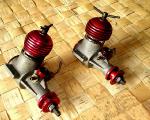
Hands up those Ozzie old-timers who busted their young knuckles trying to start an Alag? I'm one, circa 1958, who totally failed to get a friend's new Alag to even go pop. I lived with this shame until about 1961 when I watched three very, very experienced Royal Australian Air Force (Reserve) aeromodelling instructors doing no better than I had managed on one of the stinking things. Their conclusion was that the Alag was just plain un-startable—expressed at length in most colorful terms as only truly experienced RAAF NCO's can do. Good thing I never bought one, even though they were ten shillings cheaper than the equivalent Taipan (that's a dollar to whippersnappers), which would start as soon as you looked at it. So imagine my surprise when the topic came up in discussion with Adrian Duncan who said, no, good engine—still use them. Something odd here, and after a lot of research, Adrian brings us the Alag story for all to marvel and enjoy (Warning: it's a long one!  ). We are doubly indebted to Dr Walter Sturm of Roetgen, Germany, for his insights and supporting material on the Engel (Angel). If you can add or correct something, as usual, let us know.
). We are doubly indebted to Dr Walter Sturm of Roetgen, Germany, for his insights and supporting material on the Engel (Angel). If you can add or correct something, as usual, let us know.
Tech Tip of the Month
I've been reading "outside my field" again and it's made me think about boring operations (the sort that require a boring bar, not making needle valves). At the sub 5cc sizes of bore a lot of model engine makers choose to work at, boring bars are less than ideally rigid, leading to spring-back. The well established cure for this is to run the tool through and extra time or three at the same cross-slide setting as the final dimension approaches. If you've ever done this, I'm sure you've been as amazed as I at the amount the tool continues to take off at each repeated pass. Common wisdom says that when it ceases to remove metal, you have a parallel bore, and given a sharp tool, this is the case, or at least close enough for government work. Fine for a four-stroke, but for a lapped two-stroke, what was the point when the next operation is going to be to carefully hone a taper into the bore?
For this reason, I tend to use the some of the taper left by boring-bar spring-back as the "finish" size, then hone that. Experience (20 odd AHC cylinders) means I do this by feel and guesstimation. For those developing the right feel, 0.001 to 0.0015 taper in a honed cylinder for engines 1.5 to 5cc gives a good compromise between a nice TDC pinch that provides a decent operational gap between not run-in, and totally run-out. I'd also suggest that honing the taper into a parallel bore will almost certainly result in a bell-mouth bore. While this is actually a good thing at the bottom end where it reduces friction after the piston has ceased to do work (within reason as we still need primary compression for transfer), it's a disaster at the top end, especially if the liner requires a working contra-piston (think about it).
Under 1cc, things get a bit more critical. In the very small sizes, 0.5cc and under, my best results follow Peter Burford's technique, namely, a parallel steel bore with a parallel steel (not cast iron) piston which depends on the oil film for compression. The venerable Mills 0.75 used this, going to the extreme of a tool-steel piston, fully hardened, and the longevity of that engine is legendary. This brings us back to the multiple passes of the boring bar at the same cross-slide setting. Don't worry about "hitting the numbers" precisely on the bore. plus or minus 0.008" or so is not going to matter at all. Finish and regularity are more important.
So our tip this month is to be aware of the spring-back effects in small diameter bores, and when this is a bad thing, and when it can work for you.
Briefly Noted
This section is intended to alert you to little things that are hard to expand to a full news item, or cunningly wind into the Editorial, but are worthy of note never the less.
- The "People" item of the left-hand navigation menu has been totally reorganized to allow separate indexes to Pioneers, Corporations, and an aggregated Alpha index. With the exception of companies, the lists are in Last Name, First Name(s) order to make lookup easier. New pages have been added for Basil Miles, and America's Hobby Center (AHC).
- The Amco 35 page has some significant new entries and corrections.
- Point your browser to Replicas to download the first, free copy of an Indian bi-yearly e-publication dedicated to Model Engineering, and model railways, with aero-modelling, boat & ship modelling, cars & trucks modelling, paper crafts, metal working, wood working, workshop hints, etc.
- Ahoy! Pull up a bollard and sit down because if you didn't know, Peter Sellers was a modeller! Model Maker of January 1957 makes mention of his entry at a regatta, called A Boat Named Fred. How appropriate.
 Editorial
Editorial
 New Books and Magazines This Month
New Books and Magazines This Month
 Engine Of The Month: Alag/VT
Engine Of The Month: Alag/VT
 Tech Tip of the Month
Tech Tip of the Month
 Briefly Noted
Briefly Noted
 Standard Stuff
Standard Stuff




 ).
).






 .
.
